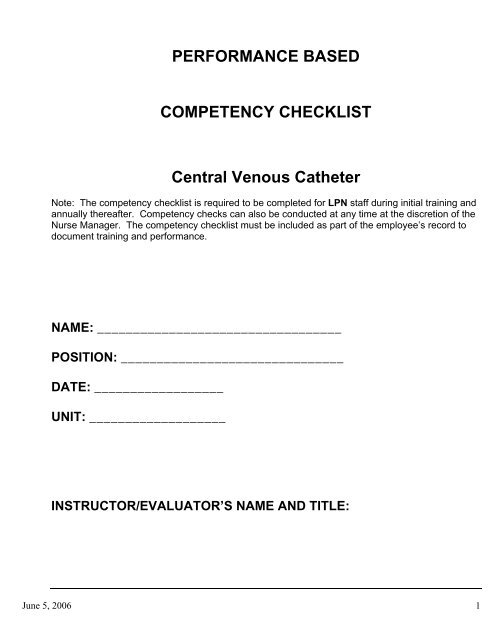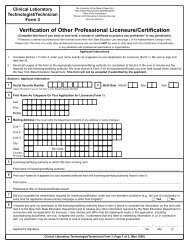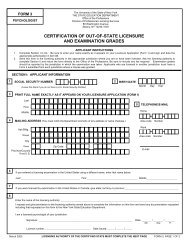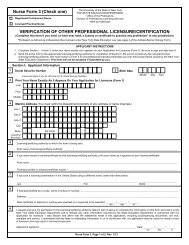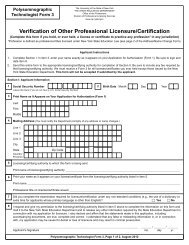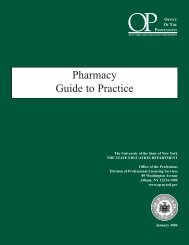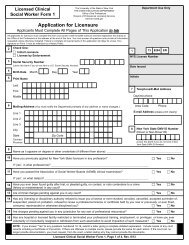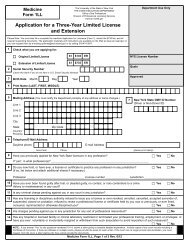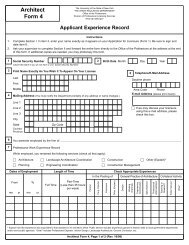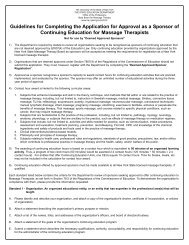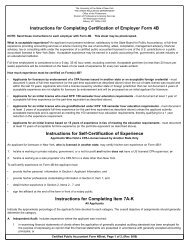Licensed Practice Nurse (LPN) Competency Checklist
Licensed Practice Nurse (LPN) Competency Checklist
Licensed Practice Nurse (LPN) Competency Checklist
Create successful ePaper yourself
Turn your PDF publications into a flip-book with our unique Google optimized e-Paper software.
PERFORMANCE BASED<br />
COMPETENCY CHECKLIST<br />
Central Venous Catheter<br />
Note: The competency checklist is required to be completed for <strong>LPN</strong> staff during initial training and<br />
annually thereafter. <strong>Competency</strong> checks can also be conducted at any time at the discretion of the<br />
<strong>Nurse</strong> Manager. The competency checklist must be included as part of the employee’s record to<br />
document training and performance.<br />
NAME: __________________________________<br />
POSITION: _______________________________<br />
DATE: __________________<br />
UNIT: ___________________<br />
INSTRUCTOR/EVALUATOR’S NAME AND TITLE:<br />
June 5, 2006 1
Central Venous<br />
Catheter - Initiation of<br />
Treatment<br />
Gathers and organizes supplies<br />
appropriate for accessing the CVC<br />
Demonstrates appropriate use of<br />
personal protective equipment<br />
(PPE)<br />
Prepares heparin and saline flushes<br />
aseptically<br />
Ensures that all persons in<br />
attendance, including the patient,<br />
are wearing a mask and the<br />
patient’s head is turned to the<br />
opposite side before removing caps<br />
and accessing the catheter.<br />
Ensure that a clean field is under<br />
the CVC<br />
Washes hands and puts on clean<br />
gloves before working with the<br />
catheter.<br />
Correctly distinguishes between the<br />
arterial and venous catheter limbs<br />
Soaks port/cap connections<br />
following manufacturer’s<br />
recommendation.<br />
Ensures the clamps of the catheter<br />
limbs are closed during cap<br />
removal/syringe placement<br />
Aspirates anti-coagulant /<br />
thrombolytic agent and aseptically<br />
flushes catheter lumens with saline<br />
Obtains pre-treatment lab samples<br />
per procedure<br />
Connects arterial and venous<br />
bloodlines aseptically to the correct<br />
catheter limbs<br />
Ensures connections are made<br />
correctly and are secure<br />
Secures bloodlines to minimize<br />
tension on bloodline/catheter<br />
connection or kinking of bloodlines<br />
Turns blood pump on per unit policy<br />
and observes for signs of<br />
inadequate blood flow rate (BFR):<br />
pre pump arterial pressure
Central Venous<br />
Catheter - Initiation of<br />
Treatment Continued<br />
Immediately reports any difficulties<br />
in achieving ordered blood flow to<br />
RN<br />
Checks venous and pre pump<br />
arterial pressure to ensure reading<br />
is in acceptable range per unit<br />
policy<br />
Date<br />
Taught<br />
Return<br />
Demonstration<br />
Date(s)<br />
Needs<br />
<strong>Practice</strong><br />
Satisfactory<br />
Performance<br />
Date<br />
Eval.<br />
Initials<br />
Staff<br />
Initials<br />
Central Venous<br />
Catheter - Dressing<br />
Change<br />
Gathers and organizes supplies<br />
appropriate for cleaning and<br />
redressing the patient’s specific<br />
brand of catheter<br />
Demonstrates appropriate use of<br />
PPE<br />
Ensures that all persons in<br />
attendance, including the patient,<br />
are wearing a mask and the<br />
patient’s head is turned to the<br />
opposite side before removing the<br />
old catheter dressing.<br />
Inspects for catheter position, intact<br />
sutures and signs of infection at the<br />
insertion site<br />
Reports unusual finding to the RN<br />
Washes hands and puts on clean<br />
gloves prior to beginning exit site<br />
care<br />
Cleans insertion site with<br />
appropriate cleaning solution<br />
Cleans insertion site area, moving<br />
in concentric circles away from the<br />
insertion site<br />
If povidone iodine solution is used,<br />
allows the solution to dry for 2-3<br />
minutes before proceeding<br />
Places appropriate dressing per unit<br />
policy<br />
Documents dressing change and<br />
observations on the treatment sheet<br />
June 5, 2006 3
Central Venous<br />
Catheter - Monitoring<br />
During Treatment<br />
Ensures the patient’s access is<br />
visible at all times<br />
Date<br />
Taught<br />
Return<br />
Demonstration<br />
Date(s)<br />
Needs<br />
<strong>Practice</strong><br />
Satisfactory<br />
Performance<br />
Date<br />
Eval.<br />
Initials<br />
Staff<br />
Initials<br />
Checks that bloodline/catheter limb<br />
connections remain secure during<br />
routine safety checks<br />
Ensures bloodlines remain secure<br />
and that there is no tension on the<br />
line or kinking of bloodlines.<br />
PRE-PUMP ARTERIAL<br />
PRESSURE Monitoring<br />
Employs appropriate observations<br />
and interventions to improve blood<br />
flow if pre pump pressure > -250<br />
Documents arterial pressure<br />
readings appropriately<br />
If necessary, reduces blood flow<br />
and documents appropriately<br />
Reviews medical record for adverse<br />
trends in arterial pressure<br />
Notifies RN of any problems<br />
achieving BFR<br />
VENOUS PRESSURE<br />
MONITORING<br />
Evaluates venous pressure values<br />
for elevated venous pressure<br />
readings<br />
Employs appropriate interventions<br />
to reduce elevated venous<br />
pressures<br />
If necessary, reduces blood flow<br />
and documents appropriately<br />
Reviews medical record for adverse<br />
trends in venous pressure<br />
Ensures RN is aware of problems<br />
with elevated venous pressure and<br />
that any adverse trends have been<br />
noted<br />
Central Venous<br />
Catheter - Termination<br />
of Treatment<br />
Prepares saline flushes aseptically<br />
June 5, 2006 4
Central Venous<br />
Catheter - Termination<br />
of Treatment Continued<br />
Checks documented fill volumes of<br />
each catheter lumen and prepares<br />
prescribed strength of anticoagulant<br />
/ thrombolytic aseptically<br />
Washes hands and puts on clean<br />
gloves prior to performing<br />
procedure. Demonstrates<br />
appropriate use of PPE<br />
Ensures that the field is clean under<br />
the catheter<br />
Date<br />
Taught<br />
Return<br />
Demonstration<br />
Date(s)<br />
Needs<br />
<strong>Practice</strong><br />
Satisfactory<br />
Performance<br />
Date<br />
Eval.<br />
Initials<br />
Staff<br />
Initials<br />
Soaks port/bloodline connection per<br />
manufacturer’s recommendation<br />
Clamps catheter limbs following<br />
reinfusion<br />
Ensures that all persons in<br />
attendance, including the patient,<br />
are wearing a mask and the<br />
patient’s head is turned to the<br />
opposite side prior to disconnection.<br />
Ensures catheter limbs are clamped<br />
before disconnection<br />
Disconnects bloodline and<br />
aseptically applies saline-filled<br />
syringe immediately to each<br />
catheter limb<br />
Flushes catheter lumens with saline<br />
and clamps each limb<br />
Checks that anticoagulant /<br />
thrombolytic dose is the correct<br />
amount for each catheter lumen<br />
Removes empty saline syringes<br />
one at a time and immediately<br />
replaces them with anticoagulant /<br />
thrombolytic filled syringe<br />
Instills dwell quickly and clamps<br />
immediately to prevent backflow of<br />
blood into the catheter lumen.<br />
Clamps each catheter limb<br />
Removes empty syringes<br />
anticoagulant / thrombolytic one at<br />
a time and immediately and<br />
aseptically applies sterile end caps<br />
Ensures catheter limbs are clamped<br />
June 5, 2006 5
CATHETER /<br />
BLOODLINE<br />
SEPARATION<br />
Assures access remains visible at<br />
all times and connections are<br />
checked with each patient/machine<br />
check during the dialysis treatment<br />
Demonstrates knowledge of nursing<br />
interventions for catheter/blood line<br />
disconnect<br />
Date<br />
Taught<br />
Return<br />
Demonstration<br />
Date(s)<br />
Needs<br />
<strong>Practice</strong><br />
Satisfactory<br />
Performance<br />
Date<br />
Eval.<br />
Initials<br />
Staff<br />
Initials<br />
CATHETER CARE<br />
Demonstrates knowledge of signs<br />
and symptoms associated with<br />
catheter related infection<br />
Notify RN of any signs and<br />
symptoms of infection<br />
Instructs patients, families, nursing<br />
homes, etc. on patient hygiene,<br />
signs and symptoms of catheter<br />
related infections, reinforcement of<br />
catheter dressing, and pros and<br />
cons of showering<br />
Comments:______________________________________________________________<br />
________________________________________________________________________<br />
________________________________________________________________________<br />
________________________________________________________________________<br />
________________________________________________________________________<br />
________________________________________________________________________<br />
Instructor Signature (s) and Date (s):<br />
Trainee Signature and Date:<br />
June 5, 2006 6


